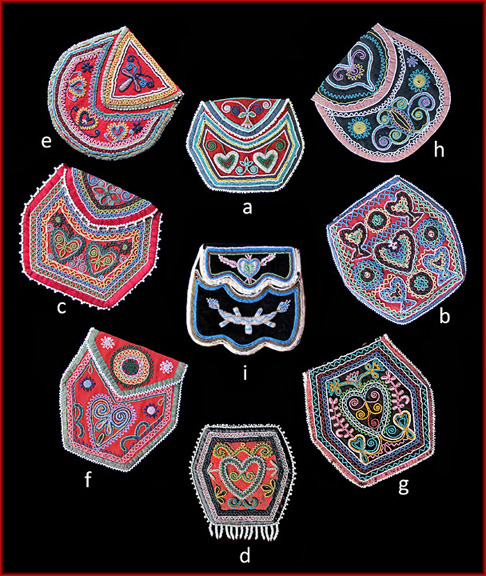Another group of bags that are of interest are those with a heart motif. The design first appeared as a metaphor on the Hiawatha (wampum) Belt, which is considered the formative record of the League of the Haudenosaunee. Each of the four squares on the belt represents the Mohawks, Seneca, Cayuga and the Oneida. The central motif symbolically represents the Onondaga, the heart of the Haudenosaunee Nation. If the heart or any of its constituent parts is harmed, all five Nations were affected.
The original meaning of a heart on the souvenir bags is lost to a former time though it may stem from European sources.
The heart shaped brooch has been called the national badge of the Iroquois because of its popularity among them. It is found in both single and double forms, often surmounted by a crown. The design is thought to have come to North America from Scotland, where it was a popular love token and betrothal symbol. The “Luckenbooth” brooch, as it was known in Scotland, may have been introduced by British-trained silversmiths such as Robert Cruickshank or James Hanna. Another possibility is that the Indians requested the brooch after seeing it worn by Scottish traders and settlers (Fredrickson and Gibb 1980:53).
Silver broaches were very popular with Iroquois women in the eighteenth century. It’s possible that they saw it as a symbol of tribal identity and its meaning was carried over into the souvenir period.
A beautifully designed bag from the first quarter of the nineteenth century is decorated with a large heart motif (example g). The artist who created this piece used a limited color palette in her design. The pleasing color combinations and the curvilinear bead strings that connect the smaller hearts to the larger one are elegantly balanced within a hexagonal enclosure. The flap (not shown) is decorated with bilaterally symmetrical strawberry leaf motifs. It’s certainly one of the masterpieces of early Haudenosaunee souvenir art.
Another splendid early bag has a large heart as its focus (example f). A pair of inward turning helix curves forms the shape of the heart. The use of the double-curve to suggest a heart may be a Haudenosaunee identity marker as it has been used this way on a number of souvenir bags. Two small sun or star motifs are placed on either side of the heart while two more flank the large sun on the flap. The organic design on the back (not shown) is atypical. It could be an early representation of a floral motif, or perhaps it has a more cosmic or dream-inspired interpretation.
By the 1840s, the designs on Haudenosaunee bags were often solidly filled with beads. The bag represented at position (i) illustrates an example of this bead fill. The solid band of beads that are strung along the perimeter of example (a) is another 1840s marker.
Fredrickson, N. Jaye and Gibb, Sandra 1980 - The Covenant Chain - Indian Ceremonial and Trade Silver. A catalog to a travelling exhibition of the National Museum of Man. Published by the National Museum of Canada / Ottawa.
